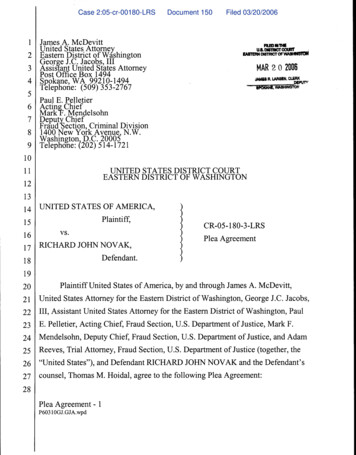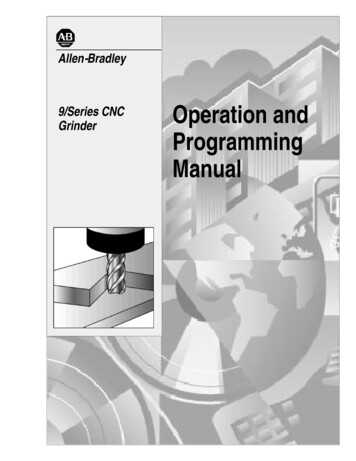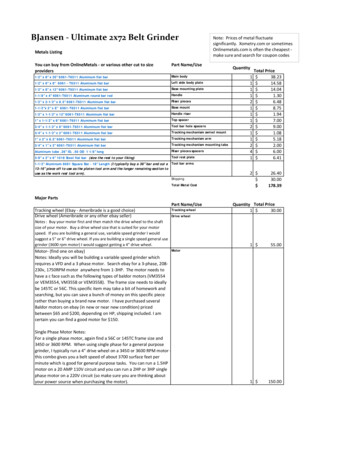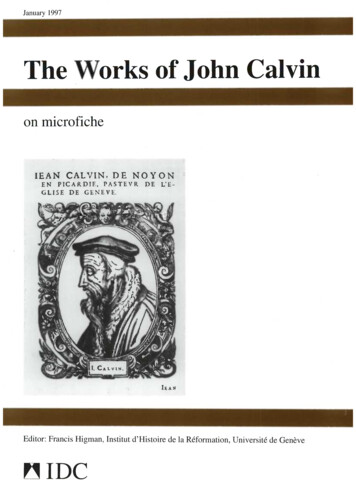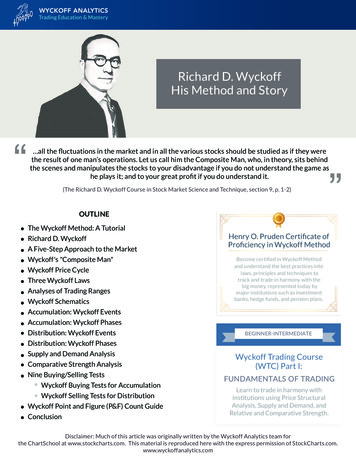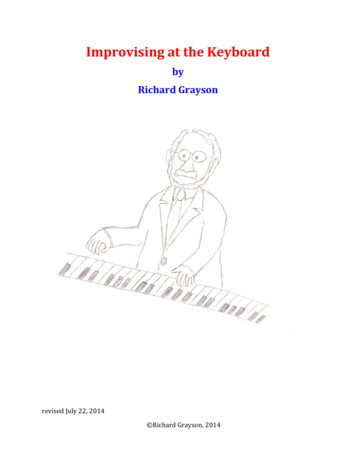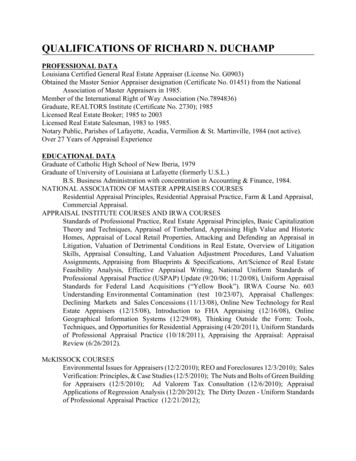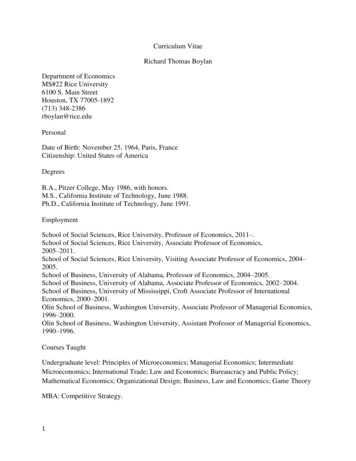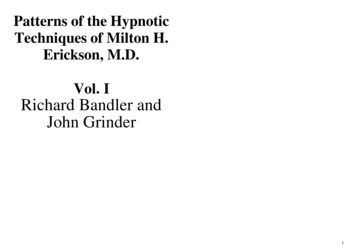
Transcription
Patterns of the HypnoticTechniques of Milton H.Erickson, M.D.Vol. IRichard Bandler andJohn Grinder1
We dedicate this bookwith the highestreverencetoGhost O.T.a littlesnow in summerandMazda(the car forpeople who can hear)2
Table of Contents.PREFACE ViiAACKNOWLEDGMENTS. . . . . . . . . . . . . . . . xiGGUIDE TO VOLUME I of Patterns of Erickson'sWork 1PART IIdentification of Patterns of Erickson's Hypnotic Work. .5Introduction: The Map Is Not the Territory. . . . . . 7Preview of Patterns. . . . . . . . . . . . . . . . . . . . . . 15The Interspersal Hypnotic Technique for SymptomCorrection and Pain Control. . . . . . . . . . . . 26Basic Trance Induction, with Commentary. . . . . 51Processes. . , , , . , . , . . . . , . , . . . , . , , , 209Transderivational Phenomena. . , . . . . . . . . , . . , 217Ambiguity. . . . . . . . . . . . . . . . . . . . . . . . . . . . . . . . 233Lesser Included Structures. . . . . , . . . , , , . . . . ,. 237Derived Meanings, . . . . . . . . . , . . . . , . . . . . , . . , 241Summary of Part III . . . . . . . . . . . . . . . . . . . . . . . 247EPILOGUE. . . . . . . . . . . . . . . . . . . . . . . . . . . . . . 253APPENDIXSyntactic Environments for Identifying NaturalLanguage Presuppositions in English. . . . . . , , . . . . , " 257BIBLIOGRAPHY. . . . . . . . . . . . . . . . . . . . . . . . . . 263A Special Inquiry with Aldous Huxley into the Nature andCharacter of Various States of Consciousness, withCommentary. . . . . . . . . . . . . . . 59PARTIIFamiliarization with Patterns of Erickson's Hypnotic Work. . . . . . . . . . . . . . . . . . . . . 127Introduction. . . . . . . . . . . . . . . . . . . . . . . . . . 129PART II (continued)Pacing, Distraction and Utilization of the DominantHemisphere. . . . . . . . . . . . . . . . . . . . . . . . . . 137Accessing the Non-Dominant Hemisphere. . . . . 179Conclusion to Part II 201PART IIIConstruction of the Patterns of Erickson's Hypnotic Work. . ., . . . , , , . . . , . . . , . . . . ,. 205Introduction. . . , , . . . , . . . . , , . , . . . . . , , . . . , . . 207Construction and Use of Linguistic Causal Modeling3
Guide toVolume I ofPatterns ofErickson's WorkMilton Erickson is internationally acclaimed as theleading practitioner of medical hypnosis. He has written morethan a hundred professional articles on hypnosis and has taughtand practiced hypnosis since the 1920's. He, more than any otherhuman being in this field, has been able both to explore and todemonstrate the vast potentials that hypnosis has to offer humanity. His ability baffles the scientific mind, and his accomplishments, typically. are either viewed as miracles or denounced asimpossibilities, although first-hand experience presents him asan undeniable reality, a striking contrast to what most peoplebelieve is possible for the mind to accomplish. Furthermore, fewof his students have learned to exercise the skills in hypnosisthat Milton Erickson uses so easily. The behavior MiltonErickson demonstrates while both inducing and utilizinghypnotic states of consciousness is extremely complex. Yet he isvery systematic; that is, his behavior has distinctive patterns.Our skill is in building explicit models of complexhuman behavior. What this means is that we build maps of thesecomplex patterns of behavior and these maps then allow otherpeople to learn and use these behavior patterns. We quote NoamChomsky's remarks1 concerning his initial formulation of amodel for modern transformationallinguistics. . . forms part ofan attempt to construct a formalized general theory of linguisticstructure and to explore the foundations of such a theory. Thesearch for rigorous formulation in linguistics has a much moreserious motivation than mere concern for logical niceties or thedesire to purify well-established methods of linguistic analysis.Precisely constructed models for linguistic structure can play animportant role, both negative and positive, in the process of discovery itself. Bypushing a precise but inadequate formulation to an unacceptable conclusion, wecan often expose the exact source of this inadequacy and, consequently, gain adeeper understanding of the linguistic data. More positively, a formalizedtheory may automatically provide solutions for many problems other than thosefor which it was explicitly designed.This volume represents our effort to perform this same service for thefield of hypnosis.When Erickson recognized this skill, he expressed the hope that thisvolume would be constructed so that other practitioners of hypnosis would haveavailable to them his powerful tools and techniques. It is the authors' intentionin this first volume to present to you some of the patterns of Erickson's behaviorin hypnosis. We intend to give you, in an easily learnable, step-bystep manner,an explicit model which will make these skills available to you in your ownwork. This book has three stages or levels of modeling, each represented by aseparate part.Part I contains several of Erickson's articles, exciting examples of hisown work. We will present a parallel commentary that will identify the patternsin his behavior. The patterns we will identify do not, by any means, exhaustwhat is present in Erickson's work. This volume is designed only to begin thisprocess, and, at the same time, to present the most essential elements ofErickson's language patterns.In Part II we will take these patterns and sort them into naturalgroupings. Hopefully, this will provide you with an overall way of bothunderstanding Erickson's work and organizing your own experience inhypnosis. Our purpose is to familiarize you with these patterns, and to showexamples in which they occur inErickson's work. This will be accomplished by excerpting smallportions of various published articles about his work, most of them of atranscriptual nature.Part III of this volume is a step-by-step, explicit presentation of thepatterns identified in Parts I and II. This Part is intended to give you the skillsnecessary to construct each pattern through an understanding of its formalcharacteristics. Our belief is that in this way the patterns of Erickson's behaviorwill be made available to you for use in your own work.We strongly recommend that you read this volume carefullyand that you spend some time experimenting with each pattern. This book isdesigned primarily as a training manual, not as a novel. Careful use and re-usewill reap the best rewards for you.FOOTNOTE1. Syntactic Structures, Mouton & Co., The Hague, 1957, p. 5.4
PATTERNSOF ERICKSON'SPART IHYPNOTIC WORKIDENTIFICATIONOF5
PrefaceAn attack of anterior poliomyelitis in 1919, shortlyafter my graduation from high school, rendered me almosttotally paralyzed for several months, but with my vision, hearingand thinking unimpaired. Since I was quarantined at home onthe farm, there was little diversion available. Fortunately, I hadalways been interested in human behavior, and there was that ofmy parents and eight siblings, and also that of the practical nursewho was taking care of me, available for observation. Myinability to move tended to restrict me to theintercommunications of those about me. Although I alreadyknew a little about body language and other forms of non-verbalcommunication, I was amazed to discover the frequent, and, tome, often startling contradictions between the verbal and thenon-verbal communications within a single interchange. Thisaroused so much of my interest that I intensified myobservations at every opportunity.The discovery that "double takes" were perceptions attwo different levels of understanding, often based upon totallydifferent experiential associations, opened a new field ofobservation. Then, when I discovered that a "triple take" couldoccur, I began mentally rehearsing the phrasing of a singlecommunication to cause differing perceptions, evencontradictory in character, at differing levels of understanding.These efforts led to the recognition of many other factorsgoverning communication such as tonalities, time values,sequences of presentation, near and remote associations, inherentcontradictions, omissions, distortions, redundancies, over- andunder-emphases, directness and indirectness, ambiguities,relevancies and irrelevancies - to name a few.Also, it became apparent that there were multiple levelsof perception and response, not all of which were necessarily atthe usual or conscious level of awareness but were at levels ofunderstanding not recognized by the self, often popularlydescribed as "instinc tive" or "intuitive."Perhaps the best simple example is the instance ofFrank Bacon's achievement during his starring role in the stageplay "Lightnin'," in which, by the utterance of the single word no at varioustimes, he conveyed at least sixteen different meanings.These meanings included an emphatic No, a subtle Yes, an impliedpromise of Not yet, an amused Don't be ridiculous, and even the exquisitenegative Not even if all bell freezes over! Altered tone of voice can constitute anactual vocabulary of transformation of verbal communication, as can bodylanguage.Then, I was introduced to experimental hypnosis by Clark L. Hull,and I became aware of the possibilities both of decreasing the number of foci ofattention and of selecting and maneuvering specific foci of attention. This led tothe combining of my awarenesses of the complexities of communication withmy understandings of hypnosis, for experimental and psychotherapeuticpurposes.Although this book by Richard Bandler and John Grinder, to which Iam contributing this Preface, is far from being a complete description of mymethodologies, as they so clearly state it is a much better explanation of how Iwork than I, myself, can give. I know what I do, but to explain how I do it ismuch too difficult for me.A simple example of this may be cited from the experience of mydaughter, Kristina, as a medical student. She happened to pick up a paper byErnest Rossi and myself, on the double bind, and, after reading it, amusedlycommented, "So that's how I do it!" Dr. Rossi, who was present, immediatelyasked, "So that's how you do what?" She explained, "Every patient has the rightto refuse permission for a rectal and hernial examination, and many patients do.But when I have reached that part of the physical examination' I tell mypatients, sympathetically, that I know they are tired of having me peer into theireyes, and peak into their ears and up their noses, and poking and thumping hereand there, but that, as soon as I complete the rectal and hernial examinations,they can say good-bye to me. And they always wait patiently to say that goodbye."While I would like still further analyses of the complexities ofcommunication for hypnotic purposes, which would require much more thanthis book by Bandler and Grinder can encompass, I would also like an analysisof how and why carefully structured communications can elicit such extensiveand effective patient responses, often not actually requested. Unquestionably,such additional studies will eventually be made. I look forward to Volume II inthis series, by Richard Bandler and John Grinder.It has been a pleasure and a privilege to write the Preface to this book.I say this, not because it centers around my hypnotic techniques, but becauselong overdue is the fulfillment of the need to recognize that meaningful6
communication should replace repetitious verbigerations, directsuggestions, and authoritarian commands.Milton H. Erickson, M.D.1201EastHaywardAvenuePhoenix,Arizona 85020AcknowledgmentsWe gratefully thank Milton H. Erickson, M.D., forpermission to quote his articles in this volume and the American Societyof Clinical Hypnosis which holds the original copyright on much of thequoted material.We also acknowledge the greatest debt to Jeanne Nixon andThe Penguin People, Artists and Typographers, of Santa Clara,California, for the design and skillful typography of this book.We would also like to thank Ernest Rossi for providing us withtapes and manuscript material.7
Introduction:The Map Is Not theTerritoryIn the authors' experience, people who use hypnosisfor medical, dental, Of psychotherapeutic purposes seem morethan any other single group to understand that we, as humanbeings, do not operate behaviorally directly upon the world, butrather we operate through a map or model (a createdrepresentation) of what we believe the world to be. A thoroughunderstanding of how people in general, and each client inparticular, create a representation of the world in which they livewill yield the practitioner of hypnosis many advantages. Amongthese will be greater speed in trance induction, more successwith a greater number of subjects, and deeper trances. Foradditional study of the processes by which people create modelsof the world, we recommend The Structure of Magic I and II. IFor our purposes here, we wish now to provide you with only abasic model of the processes by which people create models ofthe world.First, the models that we as humans create will differfrom the world of reality in three major ways. Some parts of ourexperience will be deleted, not represented in our model. This isboth a necessary and sometimes impoverishing aspect of ourmodeling processes. If we tried to represent every piece ofsensory input, we would be overwhelmed with data. However,when we fail to represent an important or vital aspect, the resultscan be devastating. In any event, we do delete parts of ourexperience when creating models of the world. These deletions,and all of the processes of modeling, go on all the time and, forthe most part, without our conscious awareness.The second way in which our model of the world willbe different from the world itself is through distortions.Distortion is a modeling process which allows us to make shiftsin our experience of sensory data. For example, we can fantasize a green cow,even
field of hypnosis. When Erickson recognized this skill, he expressed the hope that this volume would be constructed so that other practitioners of hypnosis would have available to them his powerful tools and techniques. It is the authors' intention in this first volume to present to you some of the patterns of Erickson's behavior in hypnosis .
